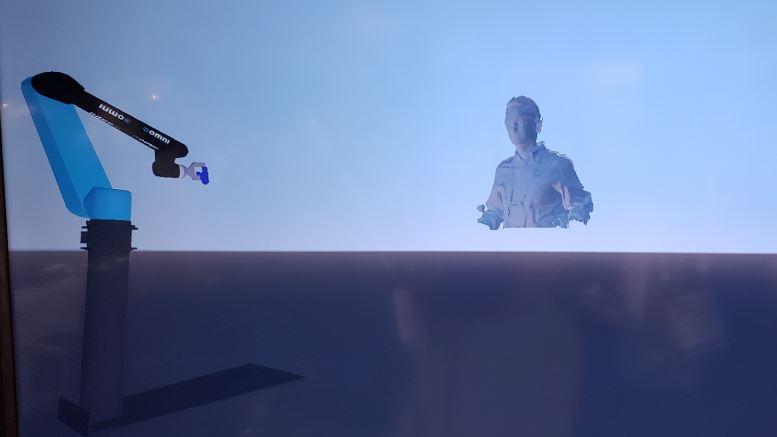Senior Editor
- FMA
- The Fabricator
- FABTECH
- Canadian Metalworking
Categories
- Additive Manufacturing
- Aluminum Welding
- Arc Welding
- Assembly and Joining
- Automation and Robotics
- Bending and Forming
- Consumables
- Cutting and Weld Prep
- Electric Vehicles
- En Español
- Finishing
- Hydroforming
- Laser Cutting
- Laser Welding
- Machining
- Manufacturing Software
- Materials Handling
- Metals/Materials
- Oxyfuel Cutting
- Plasma Cutting
- Power Tools
- Punching and Other Holemaking
- Roll Forming
- Safety
- Sawing
- Shearing
- Shop Management
- Testing and Measuring
- Tube and Pipe Fabrication
- Tube and Pipe Production
- Waterjet Cutting
Industry Directory
Webcasts
Podcasts
FAB 40
Advertise
Subscribe
Account Login
Search
FABTECH: Fabrication at an inflection point
- By Tim Heston
- November 15, 2019

Attendees at Omnirobotic's booth could be "scanned," just as a part entering a powder coating booth would be. This creates a "digital twin," which the AI-powered robot uses to teach itself the correct spray pattern.
Yesterday morning, on the final day of FABTECH, a 20-year-old welding engineer student from LeTourneau University stood during a panel discussion on skilled labor—and asked an inspiring question.
“What can we, as young people who will soon be entering the workforce, do to ensure that we’re not attending the same kind of panel discussion in 20 years?”
A moment of silence followed, then a rush of applause. It was as if the audience were giving a collective sigh and gaining a glimmer of hope. They were so happy to hear a 20-year-old ask such a question.
The technology at this year’s show stood apart from previous FABTECHs. Cobots were everywhere, along with new ways of thinking about automation of all types, from cutting and sorting to bending, welding, and finishing. On the second day of the show, I ran into an executive from AOC Metal Works, a growing and very diverse multi-plant contract fabricator in the Southeast. He told me he was looking to automate everything he could, not because he wanted to replace workers, but—thanks to record-low unemployment—automation really was the only way for his business to grow.
The industry seems to be at an inflection point. The fear of losing one’s job to automation is still there, but it’s not pervasive. A fabricator isn’t about to “automate away” its skilled people who were incredibly hard to find in the first place. Instead, those people will shepherd businesses through a new manufacturing landscape very unlike the one we have today.
I saw a hint of that landscape while visiting Omnirobotic, a company in the finishing space that’s using artificial intelligence to completely automate robotic programming. Cameras view a part entering a powder coating booth, create a “digital twin” on the fly, and from that the robot can “learn” to paint the part and ensure complete coverage. Sequencing and product mix are inconsequential, at least from a programming perspective. The robot isn’t using a previously drawn solid model, but instead a digital scan of the actual part it’s about to coat.
The company launched to help solve the labor shortage in finishing. And yes, the technology’s current iteration does have limitations when it comes to applications that require certain force and other sophisticated motion. But you can probably imagine the possibilities, from material handling to packaging, even bending. Could an AI-powered bending robot “look” at a simple bent part, grab a blank, and bend another to replicate the part it just saw? The notion might seem far-fetched. But a lot of the automated technologies I’ve witnessed this week seemed far-fetched just a decade ago.
So how will this affect LeTourneau University’s engaged welding engineering student who asked such a poignant question? The panelists gave some timeless advice. Be engaged but humble. Don’t expect revolutionary change overnight.
But over the next 20 years, that welding engineering student might see the pace of change in manufacturing accelerate faster than it has ever before. Technology might draw a new kind of worker, one who grew up with software and automation, but also has a passion for making things, and for uncovering the increasingly sophisticated ways new types of automation can help.
subscribe now

The Fabricator is North America's leading magazine for the metal forming and fabricating industry. The magazine delivers the news, technical articles, and case histories that enable fabricators to do their jobs more efficiently. The Fabricator has served the industry since 1970.
start your free subscriptionAbout the Author

Tim Heston
2135 Point Blvd
Elgin, IL 60123
815-381-1314
Tim Heston, The Fabricator's senior editor, has covered the metal fabrication industry since 1998, starting his career at the American Welding Society's Welding Journal. Since then he has covered the full range of metal fabrication processes, from stamping, bending, and cutting to grinding and polishing. He joined The Fabricator's staff in October 2007.
- Stay connected from anywhere

Easily access valuable industry resources now with full access to the digital edition of The Fabricator.

Easily access valuable industry resources now with full access to the digital edition of The Welder.

Easily access valuable industry resources now with full access to the digital edition of The Tube and Pipe Journal.
- Podcasting
- Podcast:
- The Fabricator Podcast
- Published:
- 04/30/2024
- Running Time:
- 53:00
Seth Feldman of Iowa-based Wertzbaugher Services joins The Fabricator Podcast to offer his take as a Gen Zer...
- Industry Events
Pipe and Tube Conference
- May 21 - 22, 2024
- Omaha, NE
World-Class Roll Forming Workshop
- June 5 - 6, 2024
- Louisville, KY
Advanced Laser Application Workshop
- June 25 - 27, 2024
- Novi, MI
Precision Press Brake Certificate Course
- July 31 - August 1, 2024
- Elgin,































